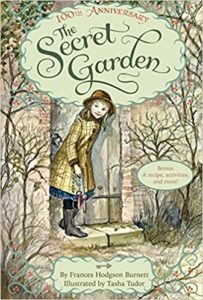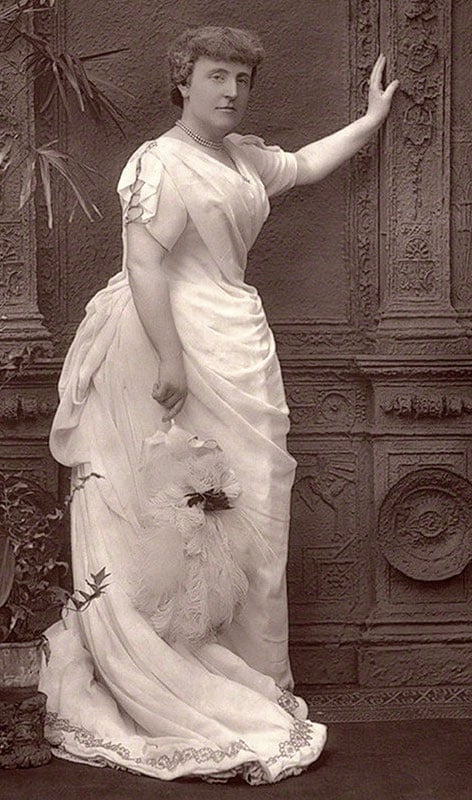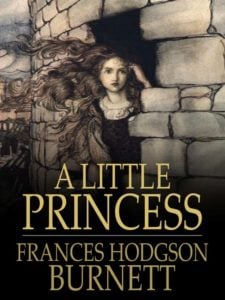Frances Hodgson Burnett, Author of The Secret Garden
By Nava Atlas | On January 5, 2018 | Updated April 22, 2023 | Comments (0)

Frances Hodgson Burnett (November 24, 1849 – October 29, 1924) was born in Cheetham, England. She emigrated to the U.S. with her mother and siblings when she was in her teens, and started publishing stories in magazines to help support her family.
Burnett is best remembered as the author of The Secret Garden, A Little Princess, and Little Lord Fauntleroy, though her prolific output went far beyond these now-classic works.
Victorian literature often had a rags-to-riches theme, or vice versa. Frances Hodgson Burnett’s own life reflected that theme. When she was born in England in 1840, she was one of five children in a household headed by a prosperous tradesman. He died when she was three, and the family’s fortunes plummeted.
Rags-to-riches in life and literature
Frances’s mother took her and her siblings and emigrated to the U.S., settling in rural Tennessee. Frances always showed an independent streak, was very clever, and had a knack for storytelling.
Her girlhood, according to the biography of her life by Ann Thwaite, Waiting for the Party, had its ups and downs. There were parties and picnics, but also great struggles to earn enough money to keep the family afloat.
That’s when Frances started to write. Much like Louisa May Alcott before her, she did so more from a desire to support her family than out of any grand literary ambitions. She sent her first story to a woman’s magazine, stating bluntly: “My object is remuneration.”
She succeeded so well at selling stories to magazines that a steady income was hers to enjoy. Her earnings were enough not only to help her family, but to pay for a trip back to her native England at age 22, the first of many such trips.
. . . . . . . . . . . .
Quotes from The Secret Garden
. . . . . . . . . . . .
Incredibly productive years
During her writing career that spanned some fifty years, Burnett produced over fifty books and thirteen stage plays. Most have been forgotten, swept into the literary dustbin that contains the legions of over-sentimental stories that were produced in that era.
She produced at least three works that have endured — Little Lord Fauntleroy, The Secret Garden, and A Little Princess. They each had strong, offbeat characters and rose above the sugary sweetness and morality of children’s tales of the era.
Writing in her garden helped her keep up her spirits in her own life, and contributed to one of her most popular works, The Secret Garden. It’s hard to say which is the more beloved of her works, the latter or A Little Princess. Burnett also helped write the theatrical versions of her books during her lifetime.
Sara Crewe: or, What Happened at Miss Minchin‘s was serialized in 1887 and published as a novella in 1888. This novella was the predecessor of what developed into A Little Princess. The Lost Prince (1915) also rose above the pack of the usual pablum, though it’s not as well known as the trio of aforementioned books.
. . . . . . . . . .

Burnett’s reputation rests on a handful of classic works for children,
but she was the author of some fifty works of fiction
. . . . . . . . . .
Little Lord Fauntleroy
Though she had enjoyed great success in selling stories from the very start of her writing career as a teen,Little Lord Fauntleroy is the story that put Burnett on the literary map. It was serialized in St. Nicholas magazine in 1885 and 1886, and published as a book shortly thereafter.
The novel tells of young Cedric, who lives in poverty with his widowed mother in New York. It’s revealed that he is Lord Fauntleroy, heir to the Earl of Dorincourt. Alison Lurie, in Don’t Tell the Grown-Ups: Subversive Children’s Literature, wrote that it’s:
“… A version of the almost universal childhood fantasy that one doesn’t really belong in this dreary little house or flat with these boring, ordinary people — that one’s real parents are important and exciting and live in a great mansion, if not a castle.”
Burnett based the character of Cedric on her younger son, Vivian. Writes Lurie:
“Cedric himself is by no means the prig and sissy he is assumed to be by people who haven’t read the book. Part of the prejudice against him is probably due to the Little Lord Fauntleroy costume, which so many unhappy English and American boys were forced into at the end of the last century …”
. . . . . . . . . . .
 . . . . . . . . . .
. . . . . . . . . .
A rich woman with spendthrift ways
Even before Little Lord Fauntleroy, Burnett’s stories and now-forgotten novels had made her wealthy. In the eearly 1880s, she and her then-husband and sons lived in Washington, D.C., very near their friend President James Garfield. By the 1890s, she had also bought a home in England.
She was a spendthrift, but also quite generous, using the royalties from her books to buy and rent houses for relatives, and showering gifts on all that she knew. She also indulged in expensive art and clothing, earning the nickname “Fluffy” for her frivolous ways.
Like L.M. Montgomery, who came a generation after her and also grappled with depression and legal troubles, Burnett wished above all to spread joy to readers as well as the people in her life. “There ought to be a tremendous lot of natural splendid happiness in the life of every human being,” she wrote.
. . . . . . . . . . . .
. . . . . . . . . . . .
Loss of a son and other troubles
Both of Burnett’s marriages ended bitterly, even scandalously, and since she was a famous author, the bad publicity that resulted caused inordinate stress. But she was a devoted mother, and quite enjoyed her sons, Lionel and Vivian.
When Lionel, the older of the two boys, contracted tuberculosis, she bought him costly toys, and did everything possible to keep his spirits up — including hiding from him the fact that he was seriously ill, and taking him from one European sanitarium to another.
His death in 1890 at age sixteen plunged her into depression, something she had experienced before and would grapple with for the rest of her life.
. . . . . . . . . . .

Frances Hodgson Burnett charcoal portrait by Samuel Johnson Woolf, 1924
. . . . . . . . . . .
The legacy of Frances Hodgson Burnett
Lionel’s death, her marital woes, and depression created a gap in what had been quite a prolific career. By the early 1900s, Burnett’s work had fallen out of favor, as the florid writing style of the 19th century was no longer in vogue.
Fortunately, Burnett recovered her spirits to create her most enduring works, A Little Princess (1905) and The Secret Garden (1911), later in her life and career. In all, she was the author of some fifty novels, with perhaps eight of them secured her legacy.
She also wrote thirteen stage plays. Just a few of her novels for adults, including The Shuttle (1907) and The Making of a Marchioness (1901), have been republished in modern editions.
Frances Hodgson Burnett died at the age of 74 in Nassau County, Long Island, NY, in 1924, and is buried in Roslyn Cemetery.
. . . . . . . . . . . .
You might also like: Quotes from A Little Princess
More about Frances Hodgson Burnett
On this site
- Illustrations from Sara Crewe (1888)
- Quotes from A Secret Garden
- Quotes from A Little Princess
- 4 Classic Books by Francis Hodgson Burnett
Major Works
Frances Hodgson Burnett wrote more than 40 novels, but these are among the few that have endured in terms of reputation:
- Little Lord Fauntleroy(1886)
- Sara Crewe, or What Happened at Miss Minchin’s (1888)
- A Lady of Quality (1896)
- The Making of a Marchioness (1901; published with its sequel the same year,
combined as Emily Fox-Seton) - A Little Princess (1905)
- The Shuttle (1907)
- The Secret Garden (1911)
- The Lost Prince (1915)
Biographies & such
- Waiting for the Party: The Life of Frances Hodgson Burnett by Ann Thwaite
- Frances Hodgson Burnett: Beyond the Secret Garden
by Angelica Shirley Carpenter & Jean Shirley - Unearthing the Secret Garden by Marta McDowell
More Information
- Wikipedia
- Reader discussion of Burnett’s books on Goodreads
- Burnett – The Online Books Page
- Carson-Newman College – Letters of Frances Hodgson Burnett
- Frances Hodgson Burnett, Legend of Children’s Literature
Film adaptations of Frances Hodgson Burnett’s works
- The Secret Garden (1949)
- The Secret Garden (1975)
- The Secret Garden (1993)
- A Little Princess (1939)
- A Little Princess (1997)
- Little Lord Fauntleroy (1936)
- Little Lord Fauntleroy (1995)
Read and listen online



Leave a Reply